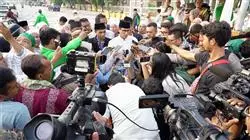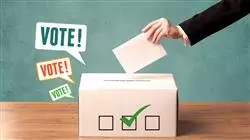University certificate
The world's largest faculty of journalism and communication”
Introduction to the Program
In just a few months, develop the capacity for in-depth and critical political and electoral analysis of an expert and give a boost of excellence to your education”

Political Communication, as well as depending on the latest decisions within national contexts and approaching everything related to a certain territory, requires an in-depth analysis which helps to interpret and question the actions of those within the government.
In this aspect, the role of the journalist is fundamental given that it is the first channel of communication between society and higher powers. The most demanding seasons for journalists is when there are elections, and they have to start from the initial idea of who the candidates are, what their proposals are, which parties they belong to and so on.
Therefore, in order for journalists to be able to operate in the political context, they must deepen and update their knowledge of information gathering, source search and format presentation. For this reason, this Postgraduate diploma seeks to perfect the journalist's skills and direct them to the world of political and electoral analysis.
This is a 100% online program, with first-hand audiovisual material created by experts in the field in order to provide the best tools. Another particularity of the program is that it can be accessed from any mobile device with an internet connection, which means that the student does not have to travel to any on-site center.
The experience of a solvent and expert university is available to you in this complete program”
This Postgraduate diploma in Political and Electoral Analysis contains the most complete and up-to-date program on the market. The most important features include:
- The latest technology in online teaching software
- A highly visual teaching system, supported by graphic and schematic contents that are easy to assimilate and understand
- Practical cases presented by practising experts
- State-of-the-art interactive video systems
- Teaching supported by telepractice
- Continuous updating and recycling systems
- Autonomous learning: full compatibility with other occupations
- Practical exercises for self-evaluation and learning verification
- Support groups and educational synergies: questions to the expert, debate and knowledge forums
- Communication with the teacher and individual reflection work
- Content that is accessible from any fixed or portable device with an Internet connection
- Supplementary documentation databases are permanently available, even after the program
A Postgraduate diploma supported by the best technology, which will allow you to learn in a fluent and efficient way”
Or teaching staff is made up of practising specialists. A multidisciplinary team of trained and experienced professionals in different environments, who will develop the theoretical knowledge efficiently, but, above all, will contribute the practical knowledge derived from their own experience to the program.
This mastery of the subject matter is complemented by the effectiveness of the methodological design, developed by a multidisciplinary team of e-learning experts who integrate the latest advances in educational technology.
In order to achieve success in this program, the professional will have the help of a innovative interactive video system, through which they will be able to put into practice the telepractice and learning from an expert systems. A concept that will allow them to integrate and fix learning in a more realistic and permanent way.
Learn all the aspects that successful political communication professionals must master"

With professors who are experts in this area of work, this program is a unique opportunity for professional development"
Why study at TECH?
TECH is the world’s largest online university. With an impressive catalog of more than 14,000 university programs available in 11 languages, it is positioned as a leader in employability, with a 99% job placement rate. In addition, it relies on an enormous faculty of more than 6,000 professors of the highest international renown.

Study at the world's largest online university and guarantee your professional success. The future starts at TECH”
The world’s best online university according to FORBES
The prestigious Forbes magazine, specialized in business and finance, has highlighted TECH as “the world's best online university” This is what they have recently stated in an article in their digital edition in which they echo the success story of this institution, “thanks to the academic offer it provides, the selection of its teaching staff, and an innovative learning method aimed at educating the professionals of the future”
A revolutionary study method, a cutting-edge faculty and a practical focus: the key to TECH's success.
The most complete study plans on the university scene
TECH offers the most complete study plans on the university scene, with syllabuses that cover fundamental concepts and, at the same time, the main scientific advances in their specific scientific areas. In addition, these programs are continuously being updated to guarantee students the academic vanguard and the most in-demand professional skills. In this way, the university's qualifications provide its graduates with a significant advantage to propel their careers to success.
TECH offers the most comprehensive and intensive study plans on the current university scene.
A world-class teaching staff
TECH's teaching staff is made up of more than 6,000 professors with the highest international recognition. Professors, researchers and top executives of multinational companies, including Isaiah Covington, performance coach of the Boston Celtics; Magda Romanska, principal investigator at Harvard MetaLAB; Ignacio Wistumba, chairman of the department of translational molecular pathology at MD Anderson Cancer Center; and D.W. Pine, creative director of TIME magazine, among others.
Internationally renowned experts, specialized in different branches of Health, Technology, Communication and Business, form part of the TECH faculty.
A unique learning method
TECH is the first university to use Relearning in all its programs. It is the best online learning methodology, accredited with international teaching quality certifications, provided by prestigious educational agencies. In addition, this disruptive educational model is complemented with the “Case Method”, thereby setting up a unique online teaching strategy. Innovative teaching resources are also implemented, including detailed videos, infographics and interactive summaries.
TECH combines Relearning and the Case Method in all its university programs to guarantee excellent theoretical and practical learning, studying whenever and wherever you want.
The world's largest online university
TECH is the world’s largest online university. We are the largest educational institution, with the best and widest online educational catalog, one hundred percent online and covering the vast majority of areas of knowledge. We offer a large selection of our own degrees and accredited online undergraduate and postgraduate degrees. In total, more than 14,000 university degrees, in eleven different languages, make us the largest educational largest in the world.
TECH has the world's most extensive catalog of academic and official programs, available in more than 11 languages.
Google Premier Partner
The American technology giant has awarded TECH the Google Google Premier Partner badge. This award, which is only available to 3% of the world's companies, highlights the efficient, flexible and tailored experience that this university provides to students. The recognition as a Google Premier Partner not only accredits the maximum rigor, performance and investment in TECH's digital infrastructures, but also places this university as one of the world's leading technology companies.
Google has positioned TECH in the top 3% of the world's most important technology companies by awarding it its Google Premier Partner badge.
The official online university of the NBA
TECH is the official online university of the NBA. Thanks to our agreement with the biggest league in basketball, we offer our students exclusive university programs, as well as a wide variety of educational resources focused on the business of the league and other areas of the sports industry. Each program is made up of a uniquely designed syllabus and features exceptional guest hosts: professionals with a distinguished sports background who will offer their expertise on the most relevant topics.
TECH has been selected by the NBA, the world's top basketball league, as its official online university.
The top-rated university by its students
Students have positioned TECH as the world's top-rated university on the main review websites, with a highest rating of 4.9 out of 5, obtained from more than 1,000 reviews. These results consolidate TECH as the benchmark university institution at an international level, reflecting the excellence and positive impact of its educational model.” reflecting the excellence and positive impact of its educational model.”
TECH is the world’s top-rated university by its students.
Leaders in employability
TECH has managed to become the leading university in employability. 99% of its students obtain jobs in the academic field they have studied, within one year of completing any of the university's programs. A similar number achieve immediate career enhancement. All this thanks to a study methodology that bases its effectiveness on the acquisition of practical skills, which are absolutely necessary for professional development.
99% of TECH graduates find a job within a year of completing their studies.
Postgraduate Diploma in Political and Electoral Analysis
In today's society, politics is fundamental for the growth and progress of a country, as it is an influential activity that ranges from public administration to the implementation of laws. For this reason it becomes of utmost importance to renew the knowledge of professionals in this sector. At TECH we have designed a Postgraduate Diploma in Political and Electoral Analysis, a high-level academic program specialized in improving your communication and interpretation skills. During 450 hours you will delve into the political culture, the socialization of ideologies and the actors and parties in the political system. This will allow you to incorporate new skills to your working career with the aim of enhancing your profile and improving your employability opportunities.
Postgraduate studies on the study of the political environment
At TECH Global University we have a team of high-level specialized experts; we provide you with the necessary elements to maximize your skills and understand the analysis techniques pertaining to this sector. You will be an expert in partisan identities, the elaboration of surveys, the management of the use of social networks and the study of electoral data pertaining to public opinion. Additionally, you will find methodologies focused on online learning, which will allow you to develop your teaching process at the times and schedules that best suit you. To take this course you only need to have a device connected to the internet.
Study at the largest digital university in the world
Political journalists who wish to improve their skills and take a course of high academic level will find in TECH the ideal option to expand their field of knowledge and revalue their professional profile. They will be able to acquire new skills focused on this sector by developing their capacity for analysis and measurement to create reports, interpret data and make use of big data in these environments. In addition, they will have a team of highly qualified teachers who will help to boost their career growth. They will also have at their disposal a curriculum designed with the latest scientific and technological advances; complemented with multimedia content, theoretical-practical lessons, participatory forums and support groups.







